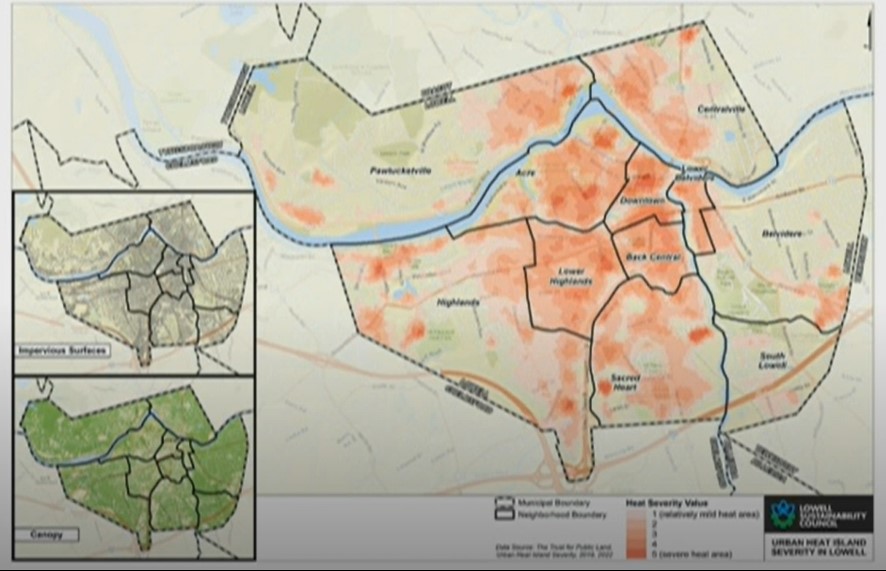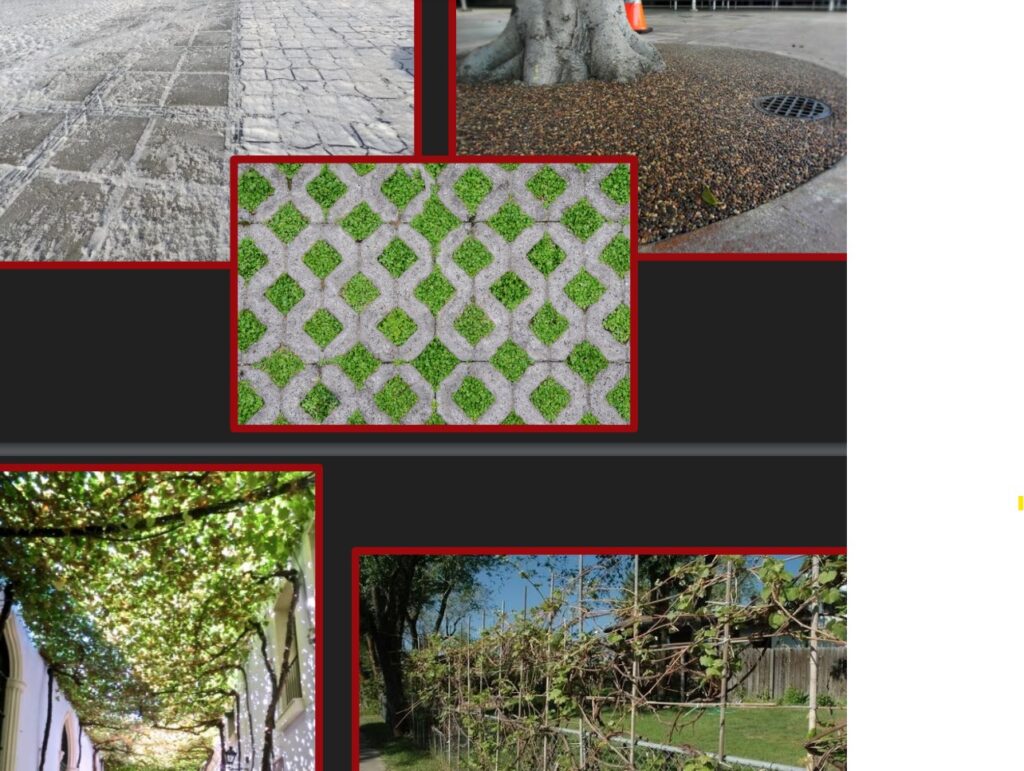
1. A Brief Recap This Week
I missed about half of the live meeting, but was able to half-listen to most of what I missed on the LTC replay. As such, I’m skipping over several topics that are probably worthy of attention. In other words, business as usual. Of note, there was plenty of room in the chamber as Mayor Chau, Councilor Rourke, and Councilor Yem were all absent.
2. Environmental Concerns or a Means to Keep Housing Illegal?

The Lowell Sustainability Council provided an informational report on the Urban Heat Island effect in the City. Heat islands are urbanized areas that experience higher temperatures than outlying areas. Structures absorb and re-emit the sun’s heat more than natural landscapes such as forests and water bodies. Urban areas, where these structures are concentrated and greenery is limited, become “islands” of higher temperatures relative to outlying areas.
The Sustainability Council provided an informative report on this effect within Lowell. The map at the top of the page identifies the relative heat level of our land area. Logically, areas with more grass, tree cover and permeable surfaces are cooler than areas comprised of asphalt and concrete.
This is obviously an issue of great concern and one that we should focus considerable effort to mitigate. However, I take issue with attempts to tie this matter to another item on the agenda: proposed ordinance that would make it easier to allow accessory dwelling units (“ADU”) in the City.
Council Nuon filed the following motion and bundled it’s discussion with the heat island presentation:
C. Nuon – Req. City Mgr. Work With DPD To Form A Zoning Policy That Requires Residential Property Owners To Designate A Portion Of Their Land As Green/Open Space.
A cynic could read this motion as a clever attempt to frustrate the intent of the ADU ordinance and throw sand in the gears of efforts to create more housing. Indeed, Councilor Gitschier specifically referenced the ADU ordinance during discussion. I think it’s telling that when the volume of ADU chatter increased, a motion appears about “green/open space” on private land lots. Would the same motion be filed to prohibit citizens from the common practice of constructing sheds, garages, driveways, or patios? I think not.
I agreed with Councilors Robinson and Drinkwater who pointed out that this is not an either/or issue. We can address both housing and the environment by implementing a number of common sense and low cost measure that would mitigate the heat island effect. Several of which were highlighted by the Sustainability Council:

I trust we will hear more about this issue as it relates to ADUs when the proposed ordinance makes its way up the ladder. When viewing housing in the context of the environment, we must keep in mind the basic truth that people need to live somewhere and there is currently not enough housing to meet this need.
Thus, we can create density or we can create more sprawl. I would argue that sprawl is far worse for the environment than smartly managed density. Sprawl leads to higher water and air pollution, increased traffic pollution, fatalities and jams, loss of agricultural capacity, increased car dependency, increased runoff into rivers and lakes, harmful effects on human health, including higher rates of obesity, high blood pressure, hypertension and chronic diseases, increased flooding, decrease in social capital and loss of natural habitats, wildlife and open space.
3. Waste Management Still Inept
[nods head]
Fin.

Feels like instead of mandating how private property owners use their land to combat the heat island, the city should instead investigate how it’s using its land. Perhaps implement more tree cover over roadways, which would provide shade to pedestrians and cyclists on hot days like today. Maybe narrow roadways that are unnecessarily wide by replacing lanes with grass/tree separated bike and pedestrian paths.
100% Ben. To his credit, Councilor Gitschier touched on this earlier in the term:
C. Gitschier – Req. City Mgr. Have The Engineering Department Look Into Adding Grass Strips Between The Road And Sidewalks On Highland Avenue During The Upcoming Paving Project.
These areas should be the standard on ALL paving projects and should include tree-cover wherever feasible. I also agree that many of the roadways are simply too wide and could benefit from grass/tree medians running down the center – Andover, Father Morissette and Dutton to name just three. Finally, we should look closer at parking minimums that give rise to acres upon acres of black asphalt.
I saw this but not sure exactly who said so sorry I cannot give credit
City Planners and Councilors Have Love Affair With Density for Density’s Sake .The call to add density in city neighborhoods is not new. For 75 years urban planners have been pushing for more residential density in cities. Rooming houses became common in the 1940s. In the 1970s, mixed use zoning became the zoning du jour. In the past several years, adding ADUs in backyards have been the latest academic, avant-garde, urban planner movement.
There’s roughly 200 million more Americans since 1940 and 130 million more Americans since 1970. There’s not enough places to house them.
I disagree that there is a “love affair” with density for “density’s sake” – that would be absurd. Planners favor density because it works. Suburban sprawl is an unsustainable Ponzi-scheme. Public roads, services, and utilities are much more expensive to maintain when homes and business are spread apart.
In light of population growth, the resultant housing crisis and an environmental crisis, I think it should be pretty clear that our growth patterns need to evolve. I’m not suggesting ADUs are always good or are sufficient to address these needs, but they offer something in the way of a solution and I’m not hearing better ideas.
And this was also in the article:
5.) City Planners’ Template of Main House/ Rental Destroys Diversity of Housing. The backyard rental house proposal, if enacted, would make all the neighborhoods susceptible to the investor/builder template of tearing down original houses and building new large houses with rental houses behind them.
There are no proposed limits on the number of these backyard rental houses allowed in any neighborhood
As you keep citing this article, I think it’s important to shed some light on the sources you bring to the table. As you cannot give credit, allow me.
The “article” on which you rely is an opinion blog by a high-end Dallas-area real estate agent named Douglas Newby. Read his blog and it is clear that he is an elitist in the extreme. Mr. Newby markets the benefits of 10,000+ square-foot mansions (“estates”) featuring massive garages, pool houses and guest houses. His clients apparently have 15 million dollar budgets. Nevertheless, he hypocritically deems the modest 500 square foot ADU a threat to the environment. His article is bereft factual data and his world-view has little to do with Lowell.
As to your/Newby’s point about the “investor/builder template” – the proposed Lowell ADU ordinance requires owner-occupancy, thus having a chilling effect on investors who don’t care about their ADU residents or the neighborhood at large.
Thank you for identifying the origin ADUs – Backyard Rental Houses Will Devastate …
https://douglasnewby.com. He has made so many valid points and can be applied to any community. Your point of owner occupied as stated in the ordinance, the remedy for owner occupied will be a Zoning Variance.
The way our new ordinance reads if there are 10 single homes on a street=10 apartments. 10 homes with apartments is not single family
And then there is the issue of oversight and enforcement by the City.
A few things on ADUs…the vast majority of ADUs are rented to family members and friends because of the owner-occupied restriction on building them. Most homeowners will not build an ADU so insinuating that 10 out of 10 homeowners would so on a street is just fear mongering. Under the proposed ordinance homeowners could only build a single ADU. ADUs are small and often unnoticeable so they don’t change the character of neighborhoods. Giving homeowners, not investors, the freedom to build an ADU allows friends and family the opportunity to age in place or lay roots in the neighborhood they love. It’s a no-brainer to support this low-key zoning change.